
Summary
1. Local planning authorities in England can secure developer contributions primarily through Section 106 agreements and the Community Infrastructure Levy (CIL).
2. Section 106 agreements are negotiated on a case-by-case basis and are aimed at addressing specific local issues that arise from development.
3. The Community Infrastructure Levy is a set charge that developers must pay, which is then used to fund broader infrastructure projects in the community.
4. Both mechanisms are essential for ensuring that development is sustainable and that it contributes positively to the community.
5. Effective negotiation and clear communication with developers are crucial for securing the best outcomes for the local community.
Main Post
In an engaging conversation with Emily Foster, a senior planner at a bustling local planning authority in England, I delved into the intricacies of securing developer contributions. Emily’s insights were invaluable, shedding light on the pivotal processes of Section 106 agreements and the Community Infrastructure Levy (CIL). Here’s a detailed recount of our discussion, aimed at demystifying these mechanisms for the benefit of our readers.
Section 106 Agreements: Tailoring Solutions to Local Needs
Emily began by explaining the essence of Section 106 agreements, which are legal agreements between local authorities and developers. “These agreements are fundamentally about addressing specific local issues that arise from new developments,” she said. “They are negotiated on a case-by-case basis, and the key here is flexibility.”
One of the most compelling aspects of Section 106 agreements is their adaptability. Emily recounted several instances where her team had successfully negotiated contributions to local schools, parks, and transport infrastructure. “For example, if a new housing development is expected to bring in a significant number of families, we might negotiate a contribution to expand nearby schools or to build new playgrounds,” she explained. “It’s all about ensuring that the development integrates smoothly into the existing community fabric.”
The negotiation process, as Emily described it, is both an art and a science. “We always start with a clear understanding of what the community needs. But we also have to balance that with what the developers are willing and able to provide,” she noted. “It’s a collaborative process, and effective negotiation skills are crucial.”
The Community Infrastructure Levy: Funding Broader Projects
Next, we delved into the Community Infrastructure Levy, or CIL, which is a more standardised approach to securing contributions from developers. “Unlike Section 106 agreements, which are negotiated, the CIL is a set charge that developers must pay,” Emily explained. “The funds collected through the CIL are then used to support broader infrastructure projects that benefit the entire community.”
Emily highlighted that the CIL is particularly effective for funding large-scale projects that might not be feasible through individual Section 106 agreements. “For instance, the CIL can be used to fund new public transport links, health facilities, or major road improvements,” she said. “These are projects that have a wider impact and can significantly enhance the quality of life for residents.”
However, Emily also pointed out some challenges associated with the CIL. “One of the main challenges is setting the right rate. It needs to be high enough to generate the necessary funds but not so high that it becomes a deterrent for development,” she explained. “It’s a delicate balance, and we often have to review and adjust the rates to ensure they are fair and effective.”
The Importance of Effective Communication
Throughout our conversation, one theme that kept emerging was the importance of effective communication. “Whether we are negotiating a Section 106 agreement or implementing the CIL, clear and open communication with developers is essential,” Emily emphasised. “We need to ensure that developers understand our goals and that we understand theirs. This mutual understanding is key to securing the best outcomes for the community.”
Emily also stressed the need for transparency with the community. “Residents need to know how these contributions are being used and how they benefit from them,” she said. “We regularly hold public meetings and provide updates to ensure that the community is kept informed and engaged.”
Conclusion: A Collaborative Effort
As our conversation drew to a close, it was clear that securing developer contributions is a complex but crucial aspect of local planning. Through a combination of flexible Section 106 agreements and the standardised Community Infrastructure Levy, local planning authorities in England can ensure that new developments contribute positively to their communities.
Emily’s insights underscored the importance of collaboration, negotiation, and clear communication in this process. “At the end of the day, it’s all about creating sustainable, vibrant communities,” she concluded. “And that requires everyone—planners, developers, and residents—working together towards a common goal.”
This enlightening discussion with Emily Foster provided a comprehensive understanding of how local planning authorities can effectively secure developer contributions, ensuring that development is beneficial for all.
By Lewis Jenkins


Be the first to comment